People who enjoy basketball games love watching professional basketball players do layups and dunks.
So, it’s no surprise that people like me who play basketball just for fun have a goal of jumping higher.
My jumps aren’t bad, but they’re just average. So working on my jumps is a constant focus. Can we do it as the famous Michael Jordan did?
Probably not. (Jordan had a 48-inch vertical. If you know basketball, you know that’s not human.)
However, we can significantly improve our jumping skills by performing specific exercises with a focus on our legs.
This article will discuss 3 hacks to jumping higher in basketball.
Hack #1 – Strengthen Your Leg Muscles
It’s challenging to navigate through life without legs.
Our legs, composed of the upper leg, knee, lower leg, ankle, and foot, not only give us support, but they offer a range of movements.
No professional basketball player will have weak legs, and no person who plays the game for fun and who wants to improve their jumping skills can do so with weak legs.
To achieve a goal of jumping higher, your leg muscles must be strong. Here are two exercises that can help you strengthen your leg muscles.
Jumping Rope
Jumping rope builds muscle by engaging not only your leg muscles, such as your calves but other muscles in your body, as well, such as your core.
Jumping rope also helps you burn calories (as much as 500 calories per half hour depending on your intensity) and improve your lung capacity and stamina.
Mastering speedy rope jumps is a highly effective way to improve your jumping skills. It is also more complicated than conventional jump roping.
If you are new at it, you will probably need to start with workouts of one to two minutes and then increase from there.
When doing speedy rope jumps, be sure to keep your abs engaged the entire time.
Speedy jump ropes can include the standard jump, crossovers, jumping on one leg, and more.
Always perform jumping rope exercises by wearing the proper supportive shoes.
Deadlifts
Another excellent exercise to improve your jumping skills for basketball is deadlifts which work the backside of your lower body, such as your back, hamstrings, and glutes.
These are part of your posterior chain, which is the entire backside of your body from head to toes.
A stronger posterior chain equates to a more powerful jump and a healthier, stronger foundation as a whole.
A deadlift exercise involves picking a weighted barbell off the floor, with both hands, and with a flat back, with no momentum.
The number of deadlifts you do and how many sets will depend on the person.
For example, beginners could work with a lower weight, for anywhere from five to eight deadlifts per set, for one to three sets.
Those who have been doing deadlifts for a while could work with heavier weights, at one to six deadlifts per set, for three to five sets.
Wear supportive shoes to take on the weight of the barbell.
It’s important to follow proper technique when doing a deadlift to avoid injury.

Hack #2 – Improve Your Vertical Jump
Michael Jordan flew across the air in his Air Jordan’s because he had many skills, including an excellent vertical jump.
In addition to the exercises already discussed, the following two exercises help to improve the vertical jump for those layups and dunks.
Squats
The squat is an excellent exercise for building lower body strength.
The squat increases vertical jump performance by over 12 percent over eight training weeks. It increases your rate of force, your tendons’ strength, etc.
To perform a standard squat, you can do so without any equipment, but be sure to wear supportive shoes. Facing forward, stand tall with your chest up and your abs tight.
Your feet should be shoulder-width apart. Your arms should be extended straight in front of you, parallel to the floor, or you can place your hands behind your head.
As if you were sitting in a chair, stick your butt as far back as possible and bend your knees. Squat down as low as you can.
While you do it, your spine should be neutral, your lower back should not be rounded, and again, make sure your abs are tight.
Your knees should be over your ankles and not over your toes. Use your heels to bring yourself back to the starting position.
Beginners should start with one set of 10 squats and work up from there. A proper technique, as with all exercises, is important with a squat.
Box Jumps
Plyometrics are exercises that use both speed and force to build muscles. They include kicking, running, jumping, etc.
Another useful plyometrics exercise for improving the vertical jump for jumping higher is the box jump.
This is an exercise that is high impact and extremely challenging, but it can greatly improve your jumping skills with practice.
The box jump is an exercise where you jump from the floor to an elevated surface, such as a box. It works your quads, glutes, hamstrings, and calves.
Because of how explosive this exercise is, you can burn many calories, 800 to 1,000 calories per hour, depending on the intensity.
To perform a box jump, you’ll need a raised surface, such as a sturdy box.
The box should be high enough off the floor to make an impact, such as 14 to 18 inches from the floor for women and 20 inches to 24 inches from the floor for men.
Jump onto the box with both feet and then straighten your legs after your legs have landed on the box. Then step down or jump down.
Stepping down will be easier for beginners. Repeat. Always wear supportive shoes when performing box jumps.
You should not attempt box jumps if you have a leg injury.
If you’re new to box jumps, as with everything else as a beginner, you should start with three or four reps and work from there.
Hack #3 – Focus on Your Technique and Speed
When it comes to jumping higher, the wrong technique and lack of speed will hamper what you’re trying to achieve. So, technique and speed are key.
You’ll jump higher when your physical and mental coordination is in synch, and your speed is in force. These two exercises will help.
Hill Repeats
One of the best ways to increase speed for jumping in basketball is with hill repeats. This exercise increases leg flexibility and strength, which helps with the vertical jump.
To perform hill repeats, you’ll need to choose a hill that provides you with at least 100 yards of climb. I used to live in a hilly neighborhood.
So finding a 100 yard or more hill used to be easy for me. I’ve since moved. So now, not so much. If you don’t have a sufficient hill in your neighborhood, you will need to find one.
If you live in a flat area, this exercise may be something you’ll be unable to do if you live too far away from hills.
With supportive shoes, run up the hill at 85 to 90 percent effort. Keep your head up, as you would in a basketball game.
Don’t run looking down.
Once you reach the top of the hill, jog back down at 30 percent effort. In other words, the focus is not on sustained sprints.
You’re not running fast up the hill and then running fast down the hill. You’ll put your effort into getting to the top of the hill, and then you’ll lower the intensity to get back down.
While you’re going down the hill at a slower pace, you’re allowing your muscles to rest a bit and prepare for the next assent.
As a beginner, try for two repeats and then increase from there.
One and Two-Footed Jumps
As explained, technique is just as important as speed for jumping higher.
When you watch professional basketball players, you will see that they all follow specific vertical jump techniques to play the game at peak performance.
There’s the one-footed jump and the two-footed jump:
One-footed Jump
The one-footed jump is very popular in basketball. Players use it for taking off and jumping up without pause.
Two-footed Jump
The two-footed jump is useful for timing an alley-oop, for example. A standard alley-oop happens at the offensive team’s basket.
Player A from team A jumps and throws the ball near the basket, and then Player B from team A jumps up, catches the ball, and dunks the ball into the basket.
The jump that Player B uses is a two-foot jump.
Understand that just jumping from a standing position will not give you as much force as if you also add the linear force of running before you leap.
The way to do that effectively is to transfer your energy to the jump the right way. Starting low to the ground, but not too low, your feet, hips, glutes, etc., will push you into the jump.
You’ll descend heel to toe with your steps, and then with two feet, you’ll jump. As you jump, your arms will swing upward as if dunking a ball into the basket.
You’ll start with just one to two steps before you jump and then increase from there as you continue your practice.
You’ll need an open space to practice, with a high enough ceiling if you’re working indoors. With this exercise and all others, you need to be consistent with your practice.

Final Thoughts
These 3 hacks for jumping higher in basketball can significantly improve your jumping technique.
However, it can’t happen without consistency and practice. Every Sunday, I map out my workout routine for the coming week. That helps me to stick to my workouts.
Even missing one or two days of a workout can make it harder to get back into it. Miss more than two days, and not only does motivation fade, but so does endurance.
Furthermore, the possibility of injury increases as well. A tight exercise schedule is not a bad thing.

[FREE DOWNLOAD] 5 Mistakes That Kill Your Vertical Jump
Did you know you may be doing some things that actually hurt your vertical jump? Download our FREE EBOOK with the 5 things you must absolutely AVOID if you want to start jumping higher.



